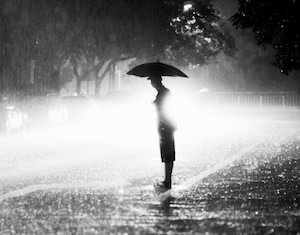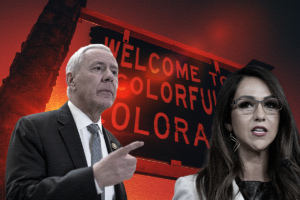Boulder Flooding: Remembering Warnings From ‘Weather Report’
Will the death and devastation from this week’s flood in Colorado simply pass us by as a mere spectacle?
By Subhankar Banerjee, ClimateStoryTellersThis piece first appeared at ClimateStoryTellers.
On Thursday as I was reading about war and peace, headlines about a flash flood in Boulder kept arriving all through the day: “At least 3 dead in Colorado flooding; Boulder ‘overwhelmed with water’” (LA Times), “Flood threat still strong as 3 killed in Colorado” (USA Today), “Boulder flood: 2nd death confirmed, county calls in National Guard to assist with rescues” (Boulder Daily Camera), “Boulder Flooding: Deadly High Waters in Northern Colorado Force Evacuations, Cause Mudslides” (Huffington Post), …
Soon I’ll talk about the flood, but first the warning.
Six years ago, on September 14, I had walked along the Boulder Creek, following the blue discs in artist Mary Miss’ outdoor art installation “Connect the Dots: Mapping the Highwater Hazards and History of Boulder Creek.” Both Mary and I were participating artists (“29 women, 12 men, 10 collaborations”) in what was quite possibly the first comprehensive art exhibition on climate change: “Weather Report: Art and Climate Change.” The exhibition idea was conceived by Marda Kirn of EcoArts; was organized by renowned curator, writer and activist Lucy Lippard; and was presented by the Boulder Museum of Contemporary Art (BMoCA) in collaboration with EcoArts.
My photographs from the Arctic were presented at BMoCA and University of Colorado’s Norlin Library. I also gave a lecture at the National Center for Atmospheric Research (NCAR), focusing on climate change issues in the far North. In addition to NCAR, Boulder also has the National Snow and Ice Data Center (NSIDC). Marda Kirn told The New York Times that Boulder has the “highest density of climate scientists in the world,” which the Times affectionately mocked in their review of the exhibition, “as if climatology Ph.D.’s were stacked like rolls of paper towels at Costco.” Boulder was indeed a perfect home forWeather Report.
On that September 14, I had difficulty imagining: A deadly flood in that little creek, really?
Mary Miss wrote in her artist statement in the accompanying exhibition catalog:
“How can the imagination be provoked to envision an event outside our daily experience, one that completely alters the landscape we occupy? How can the predicted flooding of Boulder Creek be made tangible to the residents of this city? … Looking from one point to the next, connecting the dots [painted blue discs], the level of a flood [500–year flood] is no longer abstract. This is one part of a larger study about the flooding of Boulder Creek that would more fully reveal additional aspects of the nature of a flood, and how future floods would affect the city.”
Her blue discs became very popular. Residents were not only enjoying seeing those attached to trees while walking or biking along the creek, but discs were disappearing too—vandalize would be too harsh a word, instead it’s more like people were taking a few back home like we take sand dollars from a beach. I helped Mary replace a few, fast. Mary Miss’ art was “a deceptively simple outdoor installation that powerfully illustrated the potential danger of climate change in the immediate locale,” art critic Suzanne Boettger wrote in Art in America special issue “Art & Politics.”
For the installation, she had worked with scientists from the University of Colorado at Boulder and the US Geological Survey. In fact, art–science collaboration was one of the key strengths of Weather Report. “One of the principles of this exhibition…was to give artists access to scientists working in the fields that they hoped to address,” Lucy Lippard wrote. “This process was at once fruitful and delicate. (Scientists are determined to remain politically neutral in order to retain their objectivity; artists chafe at constrictions).”
Artists, however, are often not taken seriously when it comes to addressing the climate crisis. Lawrence Wechsler had written an article on “artistic responses to global warming” in The Nation. Lippard pointed out that Wechsler “pretty much dismisses artists who address the issue ‘head on’.” She strongly objected to Wechsler’s “oversimplification” and wrote:
“At best [artists] can make the hot breath of climate change both vivid and immediate to this visually oriented society… They can also deconstruct the ways we are manipulated by the powers that be and help open our eyes to what we must do to resist and survive.”
Weather Report did “deluge the populace with artwork” exhibited all across town in numerous venues and outdoors. I surmise that no one in Boulder had imagined then that the real “deluge” would arrive—so soon.
Colorado was plagued with devastating wildfires this summer. Now come the floods. A large storm system dumped up to 10 inches of rain, since Monday, in central Colorado, causing flash floods. “Flooding extended all along the Front Range mountains, including the cities of Colorado Springs, Denver, Fort Collins, Greeley, Aurora and Boulder,” the Associated Pressreported. Boulder has been hit hardest though.
“This is not an ordinary day, it is not your ordinary disaster,” Boulder County Sheriff Joe Pelle said on Thursday. Referring to flood warning he said, “You know, we sort of roll our eyes when they say you have to be prepared for the 100–year flood, so here we are.”
“The University of Colorado–Boulder campus was closed for the remainder of the week after a torrent of water from Boulder Creek flooding damaged about 40 buildings, or about a quarter of the campus. Hundreds of students were forced to evacuate residence halls. Officials also closed Boulder Valley and St. Vrain District schools,” the USA Today reported on Thursday.About 11pm Thursday night I spoke with Anurag Agrawal, a doctoral student at the University of Colorado Electrical Engineering department. He told me over the phone:
“I attended my class on Wednesday afternoon while it was still drizzling. I went back home from school at around 6 pm with the rain getting worse. At about 8 pm, I got a text message about the flash flood warning from the National Weather Service (NWS). Then every 30–60 minutes I was getting texts from NWS as well as the university alert system regarding the status of the floods. People were advised to stay away from the Boulder Creek and try and stay at high–rise areas. I had never seen anything like this in my 7 years at Boulder, and rarely back in India. Being on the 3rd floor of a building, I felt safe inside the house but a friend of mine who lived close to the campus was evacuated like many others. The campus was declared closed on Thursday and Friday. The small boulder creek where we used to go tubing in summer has turned into a river with water flowing at 5000 cubic feet per sec!”
The Los Angeles Times reported that “officials are seeing flooding in areas that are not even close to water. Many major roads in and out of Boulder were closed or impassable, and officials were asking people to stay in their homes.”
So far three deaths have been confirmed in central Colorado. Boulder’s Daily Camera reported that the sheriff’s office “feared that more fatalities would be discovered as crews tried to make their way into the mountain towns and heavily affected areas.”
There is more rain to come though. USA Today reported that on Thursday morning the National Weather Service “posted a bulletin warning of ‘Biblical’ rainfall in some areas, forecast 6 to 10 inches could fall through the weekend.”
The AP article made a connection between wildfire and flood—both are becoming more frequent and more extreme with climate change:
“Some of the flooding was exacerbated by wildfire… That was particularly true near Jamestown in an area scarred by fire in 2010 and another near Colorado Springs’ Waldo Canyon that was hit in 2012. Rain is normally soaked up by a sponge–like layer of pine needles and twigs on the forest floor. But wildfires incinerate that layer and leave a residue in the top layer of soil that sheds water.”
Furthermore, climate change induced bark beetles infestation during the last decade killed tens of millions of pine and piñon trees, all across the southwest. As I wrote in 2010 that between 2001 and 2005, more than 54.5 million piñons—90% of mature piñons died in New Mexico from bark beetles infestation.
In 2011 the Amon Carter Museum of American Art in Fort Worth presented as exhibition of my desert photographs, Where I Live I Hope to Know. In the accompanying catalog I wrote:
When I started my walks [in 2006], I did not realize that the piñon–juniper stands across the Desert Southwest are actually old–growth forests, ancient woodlands that support an amazing diversity of wildlife, including 250 bird species, 74 species of mammals, 17 species of bats, 10 amphibian species, and 27 species of reptiles. Sadly, as I continued my photography, I began to realize that the old–growth piñon forest in New Mexico is mostly dead due to recent climate change.
The massive death and destruction of trees—from bark beetles and wildfires—turn a forest that used to be a carbon sink—to a carbon source, further contributing to climate change.
We can connect many more dots like this. But the point I’m trying to make here is that we can keep arguing whether the devastating still–unfolding flood in Colorado was caused (or amplified) by climate change (or not) or we could get serious about addressing the climate crisis. Sadly, there is no such luck in the horizon, however, as I wrote in a recent article, “Obama in the US, and Harper in Canada, in tandem, are turning North America into a petro–imperial and petro–despot continent. This does not bode well for solving the climate crisis.”
The Obama presidency has all but finished off the environmental movement in the US. The movement has essentially become what I’d call—the glass is half–full movement. The concept is most clearly exemplified by the Keystone XL pipeline issue. Environmentalists who are Obama supporters cheerily point out that he delayed the construction of the northern half of the pipeline, while critics like myself keep pointing out that he gave approval for the building of the southern half. It is a great irony that the Keystone XL pipeline has become—the Kardashian—the celebrity of the environmental movement. Under the cover of the Keystone XL Obama’s environmental policy is causing great troubles everywhere else: from drilling in the Arctic Ocean, to super–deep–water–drilling in the Gulf of Mexico, to fracking (onshore and offshore), and a recent Mint Press News investigative report stated: “many key pipeline and oil and gas industry marketing projects are currently up for expedited review, making up for—and by far eclipsing—the capacity of Keystone XL’s northern half.”
More than a decade of wars abroad has hollowed out the US economy. Now, responding to frequent climate change disasters—wildfires, floods, hurricanes—will further empty out the government’s coffer. The Empire might not need clothes to survive (bombs and drones will do), but people and all other species will still need a healthy environment—to survive.
The Weather Report: Art and Climate Change exhibition happened in 2007 that visually gave warnings about a deadly flood in the Boulder Creek. Six years have passed. America is yet to take any meaningful action on climate change. Will the death and devastation from this week’s flood in Colorado simply pass us by as a mere spectacle?
Subhankar Banerjee is a photographer, writer, and activist. His most recent book Arctic Voices: Resistance at the Tipping Point will be published in paperback on October 8 (Seven Stories Press). He was recently Director’s Visitor at the Institute for Advanced Study in Princeton, Distinguished Visiting Professor at Fordham University in New York, received Distinguished Alumnus Award from the New Mexico State University, and Cultural Freedom Award from Lannan Foundation.
Copyright 2013 Subhankar Banerjee
Your support matters…Independent journalism is under threat and overshadowed by heavily funded mainstream media.
You can help level the playing field. Become a member.
Your tax-deductible contribution keeps us digging beneath the headlines to give you thought-provoking, investigative reporting and analysis that unearths what's really happening- without compromise.
Give today to support our courageous, independent journalists.






You need to be a supporter to comment.
There are currently no responses to this article.
Be the first to respond.